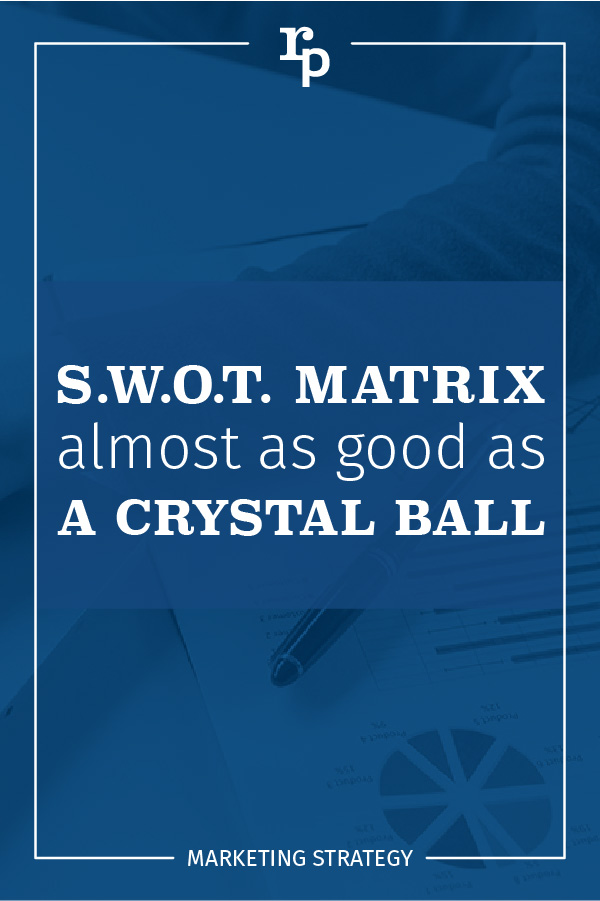The S.W.O.T. Analysis – Almost a Crystal Ball

II have often wished for a crystal ball so I could see what was going to happen next. t would make my life so much easier if I knew if the economy was going to go up or down, if new products or technologies were going to emerge on the scene or if one of my competitors was suddenly going to close up or completely change their business model.
If you are like me, you probably wish you had a crystal ball too. Unfortunately, I believe the only place to find one is on Diagon Alley, and since we don’t live in a Harry Potter novel I am guessing we won’t be heading there anytime soon.
So, instead of waiting for a magical intervention, I found a tool which won’t tell me what’s in my future but will prepare me for whatever comes my way.
The tool is called a SWOT Analysis Analysis
S.W.O.T. is actually an abbreviation which stands for Strengths, Weaknesses, Opportunities, and Threats. This tool gives you a structured way to look at your business to evaluate what you do well and what you don’t. It also forces you to look outside your business at what changes are on the horizon which may have an impact. And the last part of the S.W.O.T. Analysis is an action plan in which you match your strengths to market conditions and develop plans to work on your weaknesses so they don’t drag you down as the market changes. Here’s a closer look at how it all works:
Look Inside: Find your Strengths and Weaknesses
Strengths are the things which give you a competitive advantage. Maybe you have a unique talent or skill set, perhaps there are elements of your fulfillment process, pricing, delivery or customer service operation which are significantly better than your competitors. Trying to figure out your real strengths? These are the things you typically say when someone asks you, ” why should I buy from you?”
Be honest about your weaknesses. It is easy to come up with a long list of strengths, but your list of weaknesses is even more important. It is unpleasant to focus on things you aren’t good at, but making improvements here can help you win new customers.
Focus on things your customers will value which you don’t do well or at all. If you are missing a critical skill, take a course or find someone to whom you can outsource the project. If there is something wrong with your process which turns potential customers away or leaves them dissatisfied, change it.
You control these internal factors. You can change or improve, but only if you know what they are. If you aren’t sure you have a complete picture of your strengths and weaknesses ask customers why they do business with you, and prospects who went elsewhere why they didn’t.
Look Outside for Opportunities and Threats
Like it or not, your business lives inside a larger community. There are things which occur in the outside world which such as natural disasters, economic shifts, changes in the tax code or regulations governing your industry, the emergence of a new competing product, service or company, or management changes at key clients which will affect your business. You can’t control these elements, but taking the time to consider what you will do if, will prepare you just in case.
Putting the Pieces Together for a Clear Future
You still don’t have that crystal ball, but with your SWOT Analysis in hand, you can be prepared for whatever comes your way. Don’t just list the elements. Take time to map out how you will leverage strengths, compensate for weaknesses and identify the skills and resources you will need to activate your back up plan. Doing this before you need to can mean the difference between business success or failure. Questions to ask in the planning process:
- How can you use your strengths to take advantage of positive change or overcome threats in your market?
- How will you compensate for your weaknesses or eliminate them completely so you can take advantage of new opportunities?
- What actions will you take to stay one step ahead of any shift in your market?
SWOT Analysis Again and Again
A marketplace is a fluid entity. Things will change. Trends come and go, and so do employees, clients and competitors. The S.W.O.T Analysis is simply a snapshot in time. Use it to peer into the future every six months or so. Then adjust your strategy and tactics based on what you believe will happen next. Want more help?
ready to work on your s.w.o.t?

Rebrand with Design Thinking
What is design thinking and why is it so popular? Well, it's a process used to redefine problems...
Canning Cookies, Creating Cohorts: Google’s Advertising Shift, Explained
The devs over at Alphabet are not just trying to bolster their profit; they’re trying to make something that could be problematic better and more secure.
4 Tips for an Effective Virtual Onboarding Agenda
Virtual onboarding is here to stay As it becomes safe to return to the workplace in a...
Investing in Business Recovery
Last week, Lorraine wrote about the importance in investing in business recovery. That raises the...
